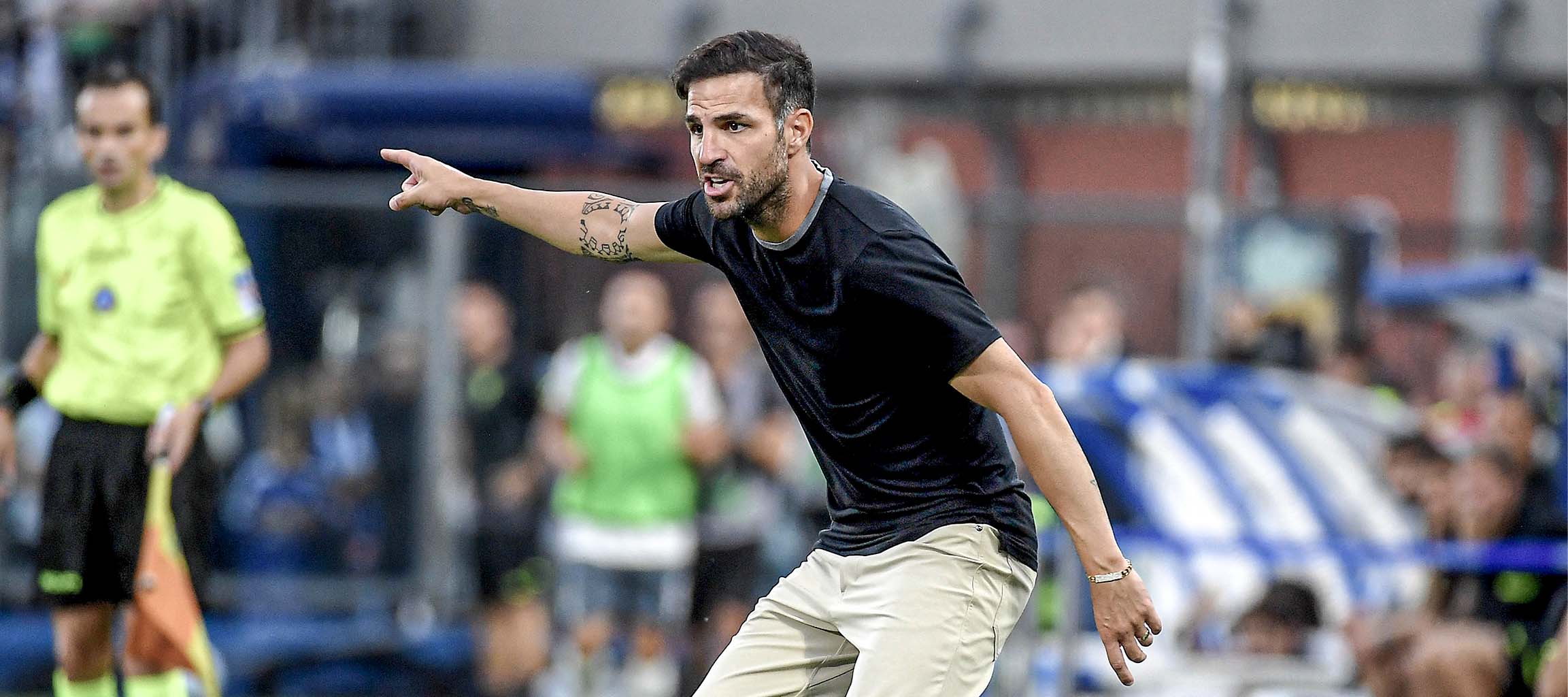
Cesc Fàbregas has made a promising start to life as a head coach with Como in Italy’s Serie A. A wonderful player for Arsenal, Barcelona, Chelsea and Spain in the pomp of his playing days, Fàbregas has been cutting his coaching teeth at a club where success has historically been more difficult to achieve. Nonetheless, after being appointed permanent manager of Como in July 2024, he led them to a respectable 10th place in their first season back in the top flight in 21 years. In fact, it was the first time Como had managed to stay in Serie A in more than 30 years.
Above, you can see Fàbregas talk tactics in a Coaches’ Voice exclusive Masterclass. Below, our UEFA-licensed coaches have analysed his tactics with the Italian club.
Flexible pivot movements
Mostly utilising a 4-2-3-1 structure with Como, Fàbregas has encouraged his side to play with possession to build and create. This has not come at the expense of attacking, however, as he encourages his team to play penetrative football.
During build-up, one of his double pivot often drops towards the ball, with rotations taking place around and ahead. When a full-back advances, the dropping pivot moves wider to cover and support alongside the rest of the back line. That allows Como to maintain a back-four build, with both centre-backs in the middle of the defensive unit. It also means they have defensive stability on transition, should they lose possession early in their build.
When the build is progressing, a temporary single pivot (Máximo Perrone in the image below) is then used to link the back line to the midfield. From here, the full-back (Mërgim Vojvoda) advances, encouraging the winger (Nico Paz) on that side to narrow to maintain at least a three-player presence in central midfield. The initial number 10 (Maxence Caqueret) then adapts to move across, creating support either side of the single central forward. Fabregas’ side have then occupied both inside channels simultaneously, ready to attack through the middle or wide.
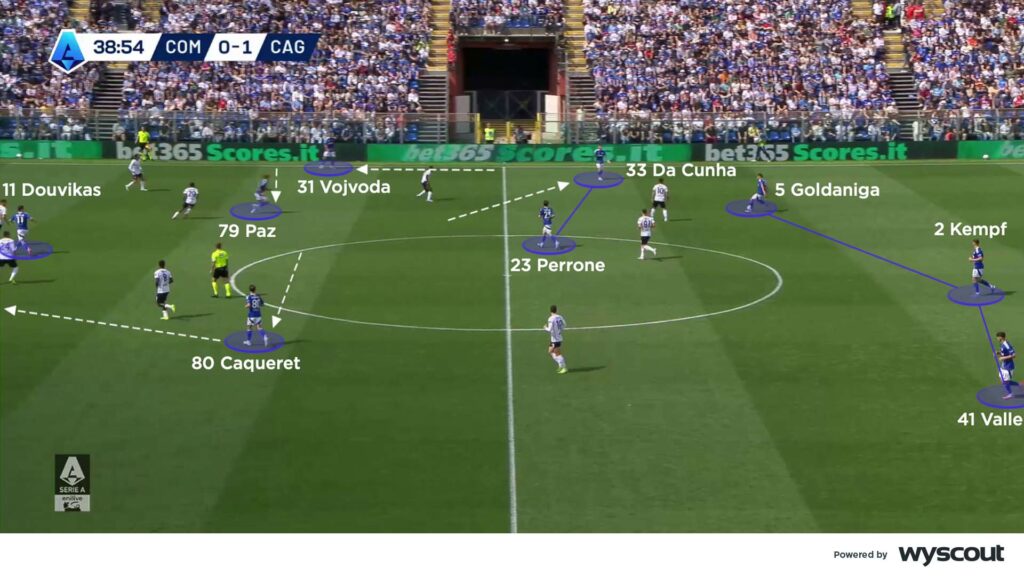
On other occasions, the pivot has dropped between and split the two centre-backs. In this case, when Como have lost possession they have been more vulnerable through the centre during transitional moments, with both centre-backs positioned slightly wider than ideal.
There are in-possession positives for this particular movement, however. It encourages both full-backs to move forward as Fàbregas’ side build with a temporary back three of the dropping pivot and two centre-backs. Ahead, the midfield base is again occupied by a single pivot (now Caqueret in the example below), with a winger on one side moving inwards and the 10 adjusting across. Como then have a diamond shape that occupies the centre with numbers (below), to combine and to receive penetrating passes between the lines from the back three.
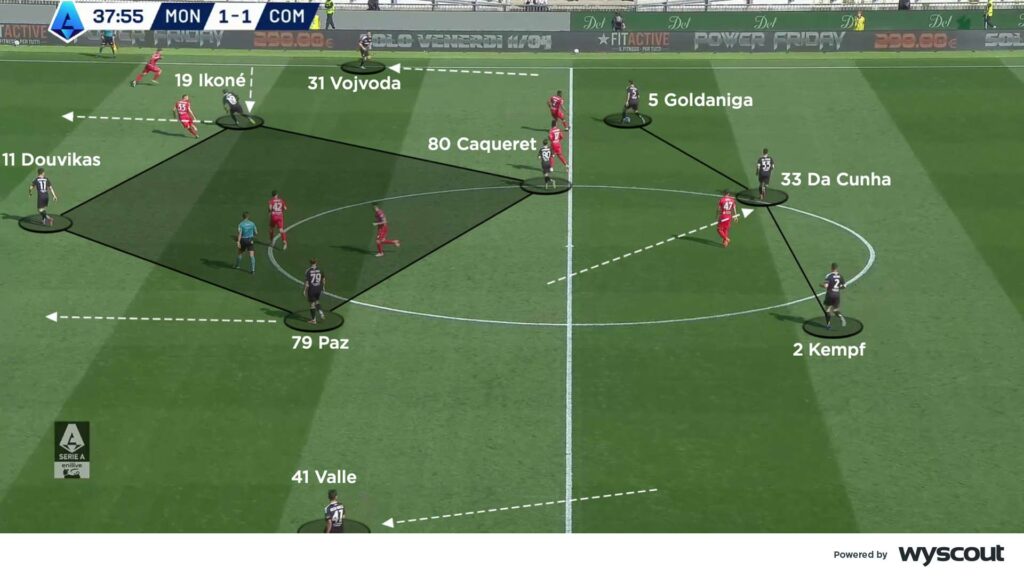
Although this rotation during build-up may weaken Como on defensive transition, it does give them another player ready to attack higher, who is better positioned to create attacking overloads later on. With this rotation Como will usually attack with a slightly different balance. On one side of the pitch they will have a winger and full-back pair to combine, while on the other is a lone full-back, as the other winger attacks from a narrowed position. Como’s use of this rotation under Fàbregas has typically depended on available player qualities and opposition weaknesses.
Penetrative attacks
Once Fàbregas’ side have secured their build, they have looked to use particularly penetrative passing, with frequent runs in behind. His centre-forward often makes runs beyond the opposing back line. With teammates occupying the inside channels, penetration can also come from those spaces as well. Players in slightly withdrawn attacking positions are then able to regularly pass forward and find runs beyond, including from the number 10 and one of the narrowed wingers.
In the 2024/25 Serie A season – Fabregas’ first full year in charge – his Como side played the fourth-most through balls. When rotations or sustained build-up hasn’t been required, maximum width – usually from the wingers – has given an option to slide the ball into wide areas. Additionally, the nine and 10 often combine closely and provide runs to support each other in central spaces. Indeed, when attacking Como can sometimes resemble a 4-4-2 or 4-2-4 (below).
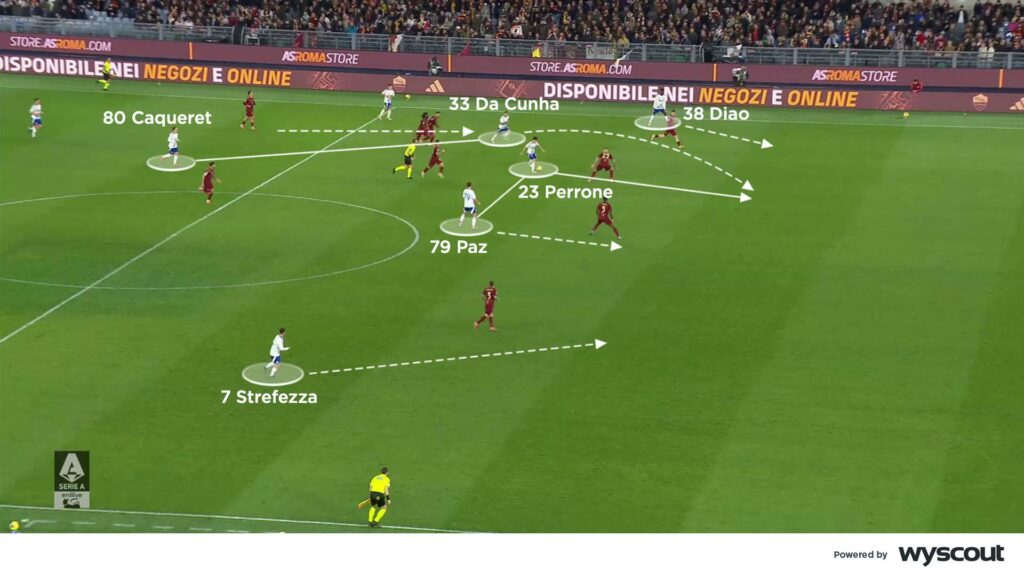
As well as creating chances, Como players’ regular runs can also have the effect of shifting and pushing the opposing back line deeper as they track and cover. Even back lines that try to hold their ground and play offside will still shift deeper, albeit more incrementally. Como then have bigger space between the lines, from which shots outside the box have yielded chances and goals.
As with Fàbregas the player, his Como team have been clever when creating passing combinations in tight areas – especially within the central three lanes in the final third. The narrowed movements of both their wingers, plus the nine and 10 working off each other, has delivered quality central combinations. The pivots then push higher to squeeze the pitch, locking play high. This support also helps create attacking combinations that can utilise an initial backwards pass or set.
Narrowed runs through the inside channels have also been useful when the centre is overly congested, such as below. While Como’s angled passes and runs don’t necessarily penetrate in behind, they are progressive and purposeful. As such, Como played the fifth-most progressive passes in Serie A in the 2024/25 season.
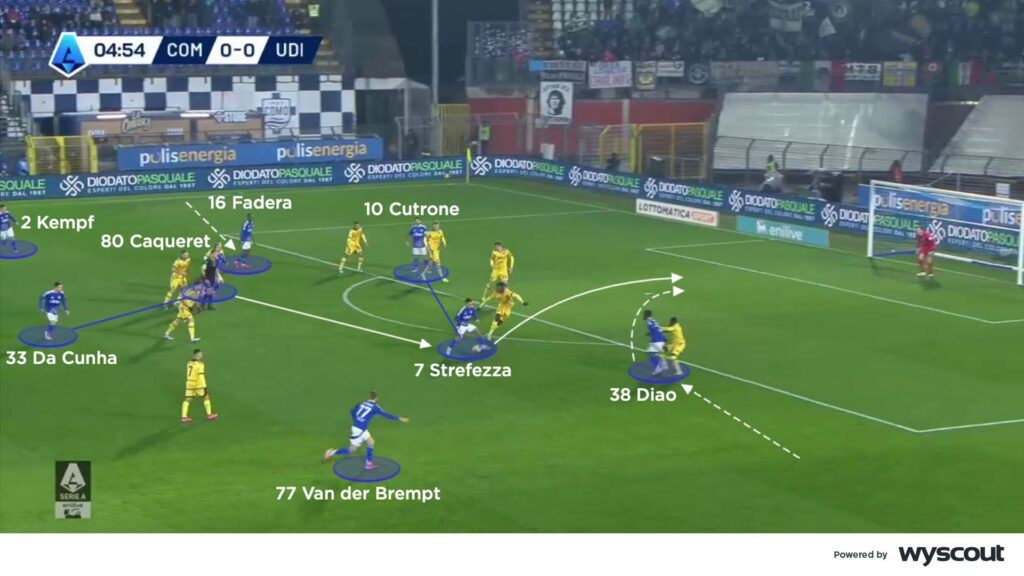
Defensive use of the 4-4-2
Out of possession, Fàbregas’ Como have often formed a 4-4-2 or variants of it. The most simplistic version involves his number 10 moving higher to join the centre-forward as the first line of pressure. From there the midfield narrows and readjusts to become a unit of four ahead of the defence.
Where possible, his side looks to force the ball wide, setting traps to jump along and towards the touchline, with the nine and 10 attempting to force play around. If the opposition have a pivot positioned to receive a pass that splits Como’s first line of two, one of Como’s central midfielders takes up a half-and-half role, ready to jump on to the pivot. Como’s far-side winger narrows aggressively – the further wide the nine and 10 have locked play on the opposite side, the more this winger comes across (as with Assane Diao, below). The winger on the closest side is very aggressive in pressing along the touchline, backed up by the full-back.
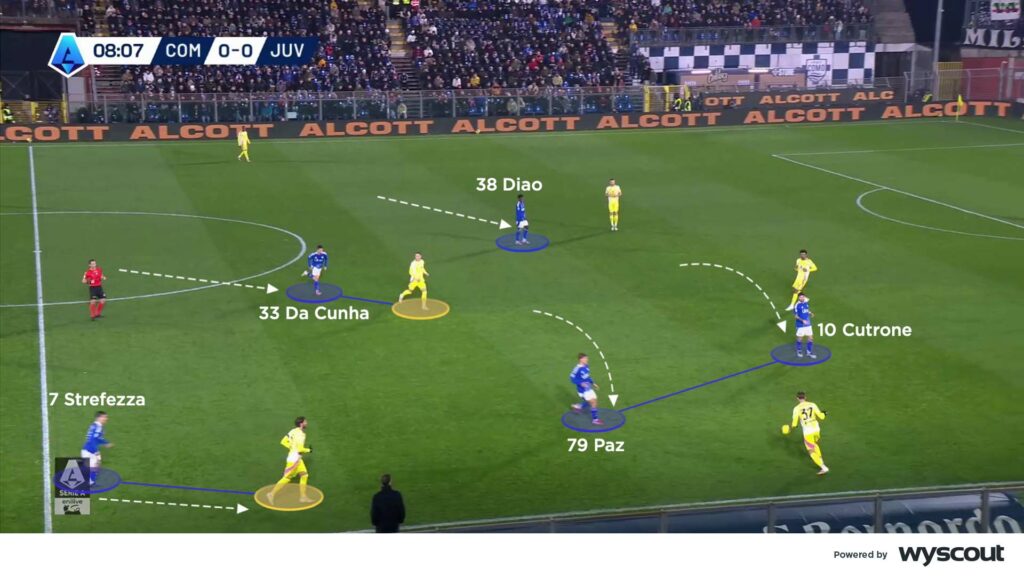
It was no coincidence that, in 2024/25, three of Como’s top four defensive duellers were wingers Alieu Fadera and Gabriel Strefezza, and attacking midfielder Paz. The latter often jumped high to press with the number nine. Fàbregas’ team also ranked fifth for PPDA in Serie A and third for challenge intensity – a combination of all defensive actions when the opposition has the ball. However, Como were lowest for interceptions, because they looked to aggressively compete for possession man-for-man, rather than screening or marking multiple players in an attempt to intercept passes.
Fàbregas has varied the way in which his team presses. For example, it has sometimes been a single nine who has attempted to lock the play one way, leaving the 10 to sit deeper in midfield. But if Como’s far-side winger hasn’t jumped, the opposition have then been able to bounce the ball to their spare centre-back. Fàbregas has also used two 10s supporting the nine to put more pressure in central areas, but again with slightly less success compared to the wide pressing traps seen with the 4-4-2.
In a more withdrawn block, Como have applied similar defending patterns, with the first line of nine and 10 forcing the ball wide. The midfield narrows as a four, with aggressive wingers ready to jump out from the more set block that defends the middle third (below). There have also been moments where other individuals within the block have jumped. This includes a full-back or centre-back supporting the midfield to deal with a dropping attacker if the opposition have penetrated.
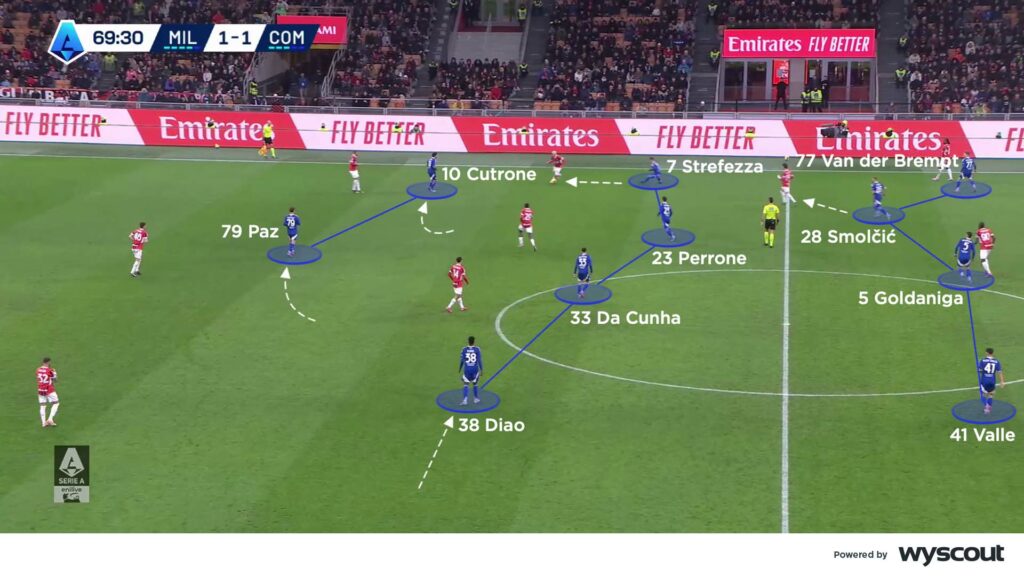
As you would expect from an individual who was such a cerebral player, Cesc Fàbregas has shown signs of being a very tactically astute coach. How his managerial career pans out from here will be fascinating to observe.
Want to know more about football tactics and learn how to coach from the very best? Take a look at the Coaches’ Voice Academy here

